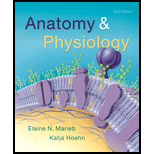
The lowest blood concentration of nitrogenous waste occurs in the (a) hepatic vein, (b) inferior vena cava, (c) renal artery, (d) renal vein.
Introduction:
The urinary system or renal system is made up of kidneys, ureters, bladder and the urethra. All these organs are essential for the elimination of nitrogenous waste from the body. This system also regulate blood volume and blood pressure by controlling the levels of electrolytes and metabolites. Kidney consists of extensive blood supply through the renal arteries that leave the kidney via the renal vein. The concentration of the nitrogenous waste shows variation in different part of blood supply.
Answer to Problem 1MC
Correct answer:
Renal vein consists of the lowest blood concentration of nitrogenous waste.
Explanation of Solution
Explanation for the correct answer:
The veins that drain the kidney is known as renal veins. These veins connect the kidney to the inferior vena cava. The blood carried by these veins undergo filteration process in the kidney and consists the lowest amont of nitrogenous waste. Hence option (d) is the correct option.
Explanation for the incorrect answers:
Option (a) states that hepatic vein contains the lowest amount of nitrogenous waste. The hepatic vein transports the deoxygenated blood from the liver to the heart through the inferior vena cava. Hence this is an incorrect option.
Option (b) states that inferior vena cava contains the lowest amount of nitrogenous waste. Inferior vena cava is a large vein that carries deoxygenated blood from body into the right atrium of the heart. Hence this is an incorrect option.
Option (c) states that renal artery contains the lowest amount of nitrogenous waste. The renal artery supplies oxygenated blood to the kidneys, which is not filtered. Hence option (c) is an incorrect option.
Thus it is concluded that renal veins consists the lowest blood concentration of nitrogenous waste.
Want to see more full solutions like this?
Chapter 24 Solutions
Anatomy & Physiology (6th Edition)
- Amino Acid Coclow TABle 3' Gly Phe Leu (G) (F) (L) 3- Val (V) Arg (R) Ser (S) Ala (A) Lys (K) CAG G Glu Asp (E) (D) Ser (S) CCCAGUCAGUCAGUCAG 0204 C U A G C Asn (N) G 4 A AGU C GU (5) AC C UGA A G5 C CUGACUGACUGACUGAC Thr (T) Met (M) lle £€ (1) U 4 G Tyr Σε (Y) U Cys (C) C A G Trp (W) 3' U C A Leu בוט His Pro (P) ££ (H) Gin (Q) Arg 흐름 (R) (L) Start Stop 8. Transcription and Translation Practice: (Video 10-1 and 10-2) A. Below is the sense strand of a DNA gene. Using the sense strand, create the antisense DNA strand and label the 5' and 3' ends. B. Use the antisense strand that you create in part A as a template to create the mRNA transcript of the gene and label the 5' and 3' ends. C. Translate the mRNA you produced in part B into the polypeptide sequence making sure to follow all the rules of translation. 5'-AGCATGACTAATAGTTGTTGAGCTGTC-3' (sense strand) 4arrow_forwardWhat is the structure and function of Eukaryotic cells, including their organelles? How are Eukaryotic cells different than Prokaryotic cells, in terms of evolution which form of the cell might have came first? How do Eukaryotic cells become malignant (cancerous)?arrow_forwardWhat are the roles of DNA and proteins inside of the cell? What are the building blocks or molecular components of the DNA and proteins? How are proteins produced within the cell? What connection is there between DNA, proteins, and the cell cycle? What is the relationship between DNA, proteins, and Cancer?arrow_forward
- please fill in the empty sports, thank you!arrow_forwardIn one paragraph show how atoms and they're structure are related to the structure of dna and proteins. Talk about what atoms are. what they're made of, why chemical bonding is important to DNA?arrow_forwardWhat are the structure and properties of atoms and chemical bonds (especially how they relate to DNA and proteins).arrow_forward
- The Sentinel Cell: Nature’s Answer to Cancer?arrow_forwardMolecular Biology Question You are working to characterize a novel protein in mice. Analysis shows that high levels of the primary transcript that codes for this protein are found in tissue from the brain, muscle, liver, and pancreas. However, an antibody that recognizes the C-terminal portion of the protein indicates that the protein is present in brain, muscle, and liver, but not in the pancreas. What is the most likely explanation for this result?arrow_forwardMolecular Biology Explain/discuss how “slow stop” and “quick/fast stop” mutants wereused to identify different protein involved in DNA replication in E. coli.arrow_forward
 Human Biology (MindTap Course List)BiologyISBN:9781305112100Author:Cecie Starr, Beverly McMillanPublisher:Cengage LearningEssentials of Pharmacology for Health ProfessionsNursingISBN:9781305441620Author:WOODROWPublisher:Cengage
Human Biology (MindTap Course List)BiologyISBN:9781305112100Author:Cecie Starr, Beverly McMillanPublisher:Cengage LearningEssentials of Pharmacology for Health ProfessionsNursingISBN:9781305441620Author:WOODROWPublisher:Cengage





